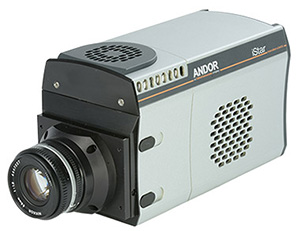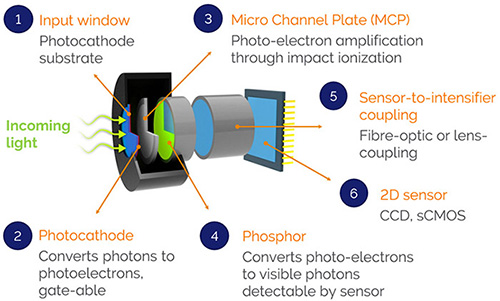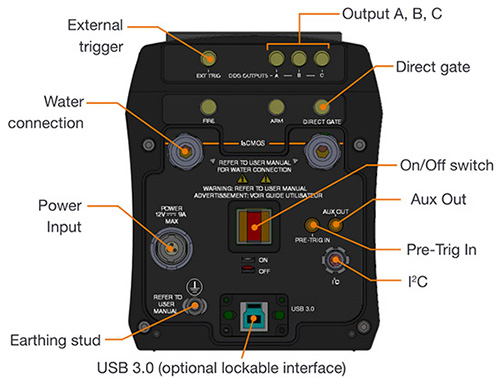Resources
 Part of the Oxford Instruments Group
Part of the Oxford Instruments Group
Expand
Collapse
 Part of the Oxford Instruments Group
Part of the Oxford Instruments Group
An intensified camera is designed to acquire images at nanosecond time scales with the ability to amplify signals. Andor's iStar CCD and iStar sCMOS can be single photon sensitive. This page addresses frequently asked questions about intensified CCD and sCMOS cameras.

An intensifier is a component added in front of a camera sensor that is designed to use electronics to gate and/or amplify the photon signals before reaching a camera sensor. Intensified cameras are often used when very low photon fluxes and gating between ns to ms time scales are necessary.
A photocathode, MicroChannel Plate (MCP), phosphor, and intensifier-to-sensor coupling.

A photocathode is a photosensitive substrate layer that generates photoelectrons from the incoming photons. This component also provides the fast shuttering/gating capability (down to nanosecond or sub-nanosecond): this is achieved by quickly switching the high voltage differential (electric field) between the photocathode substrate and the MCP input. The main characteristics of photocathodes are their probability to absorb incoming photons (Quantum Efficiency, or QE) and their resistivity (linked to their shuttering speed ability).
An MCP has microchannels so that when a voltage is applied across it, incoming photoelectrons will collide with the microchannel walls of the MCP and generate secondary electrons with each electron collision with the walls of the channels. This process amplifies the signal before reaching the camera sensor.
A phosphor converts photoelectrons from the MCP to photons in the visible spectrum that are most easily detected by the camera sensor (wavelengths where the Quantum Efficiency (QE) of the sensor is high).
The intensifier-to-sensor coupling, either through fibre optic bundles or through lens couplings, directs the spatially dependent signal from the phosphor to the correct spatial location of the sensor.
An intensified camera is needed when up to ns time scale shuttering and possibly amplification of signal is needed. See below for time scales of acquisitions with different camera types:
*Note: Different types of shutters and chopper wheels used with the cameras above may allow for somewhat different time scales.
sCMOS iStars can achieve higher dynamic ranges at faster acquisition rates (10-4000 Hz) than ICCD cameras. The dynamic range increase is due to lower readout noise as well as the larger number of pixels available to be binned. The faster acquisition rates are due to rows of pixels being able to be read out at a time by sCMOS cameras rather than single pixels being read out at a time by CCD cameras.
The cases where Intensified CCD cameras are still best suited is when low dark current is needed for long exposure times. You can learn more about an Introduction to Intensified Gated CCD Cameras (ICCDs) through our CCD introduction webinar or our CCD technical article.
Yes, each photon that is converted to a photoelectron by the photocathode is amplified by the microchannel plate (MCP) in the intensifier so that the useful signal originating from the one photon can overcome the sensor noise floor. Note that the probability of generating a photoelectron from an incoming single photon is dictated by the Quantum Efficiency (QE) of the photocathode. Other internal sources of noise like electron background illumination (EBI, i.e. photocathode thermal noise) or noise factor (linked to the MCP amplification distribution) can further affect the ability to detect the single photon. Phosphor efficiency, optical coupling, and sensor QE must also be taken into consideration.
While both of these types of cameras are capable of discriminating single-photons, EMCCDs have larger Quantum Efficiency (QE) than intensifiers, but lack the fast time gating of intensifiers. Therefore, the higher QE of EMCCDs means that fewer incoming photons are lost. However, if sub-μs timescale resolution is needed, then the gating capability of an intensifier is needed. (For example. If it is necessary to remove laser scatter light from fluorescence signal or sample very fast transient phenomena without blurring).
Yes, iStar intensified cameras can be mounted to Shamrock, Kymera, Mechelle, and 3rd party spectrometers. iStar cameras can also be used for imaging with C-mount and F-mount lens, and can easily be swapped between different experiments to fully exploit the versatility of such platforms. This enables ns time-resolved measurements such as chemical fingerprinting as well as imaging of the same phenomena.
When it comes to sensors, dynamic range represents the available useful signal range above the noise floor and below saturation. It is usually defined as the ratio of pixel well depth to the noise floor. For example a pixel well depth of 100,000 electrons divided by a 2 electron noise floor would give a dynamic range of 50,000:1.
Dynamic range can be further reduced by the signal amplification mechanism of the MCP. Therefore, we recommend to only apply the necessary gain to just overcome the sensor noise floor to preserve dynamic range. Maximum gain should only be applied for single photon counting).
Digitization (such as 12-bit, 16-bit, or 32-bit) represents the sampling granularity of the available signal captured by the sensor before saturation. (Usually specified as 2^(Nbits) where Nbits is the number of bits such as 16 for a 16-bit mode of operation. For example, 16-bit represents 2^16=65,536 levels of grey)
Yes, the iStar sCMOS can achieve fast dual frames down to ~300 ns (interframe time) between a pair of images, whereas interline CCDs typically require ~2 μs between taking two images in quick succession.
The iStar sCMOS can sustain 50 full frames per second (2x2 binning) or up to 4008 frames or spectra per second cropped to 8 rows region of interest (ROI).
Yes, the iStar has its own Digital Delay Generator (DDG) with 3 outputs that can be used to control the timing of other instruments such as lasers, oscilloscopes, etc. through TTL pulses and either Solis software or bespoke SDK applications. (See the top right three SMA outputs in the figure below).

Intensified cameras can be used for a range of different spectroscopy and imaging techniques ranging from the UV to the visible whenever fast (up to nanosecond time scale) gating is required. In the following sections we will introduce different spectroscopy and imaging techniques and applications including:
When doing PLIF, lasers beams, often stretched with cylindrical lenses into a laser sheet, are used to excite molecules in a gas or liquid and the fluorescence emission of the excited molecules is used to track scalar properties of a flow such as temperature. iStar intensified cameras are used to gate away laser scatter and only accept light for the 100s of ns or so that the fluorescence signal requires to decay.
Micron sized particles or fluorescent particles are seeded into gas or liquid flows in order to track the movement of the flow by collecting light scattered or emitted from the particles. When a pair of images is taken by a camera with a known time delay of the images, then the velocity of the particles can be calculated by dividing their displacement by the time interval between images.
Depending on the propagation speed of flow under analysis, interframe requirements for Particle Imaging Velocimetry (PIV) can range from microseconds to few hundreds of nanoseconds. Read more about using an iStar sCMOS for Particle Imaging Velocimetry.
An iStar intensified camera is able to acquire faster time scale images than many other types of cameras with the fast shuttering of its intensifier in order to accomplish PIV in faster flows. Additionally, the signal can by amplified by the intensifier in lower light conditions. The sCMOS iStar is capable of taking pairs of images with as low as 300 ns (the optical interframe time) time delay between the pair of images (with a P46 phosphor that has a decay time to 10% in 200-400 ns), whereas interline CCDs that were previously used for PIV typically can only take one pair of images 2 μs apart and then take substantially longer to read out that pair before taking more images. However, with interline CCD image pairs, there are often differing exposure times between the two images in the pair causing differences in the background signal levels of the two images.
Plasmas, generated from solids, liquids, or gas by laser excitation, are utilised to determine the composition of materials. The short times scales of the generated plasmas require that intensified cameras provide fast shuttering to capture ionic, atomic, or molecular spectra from the plasma when coupled with a spectrograph.
MTV uses lasers to “write” patterns by the excitation of seeded molecules in a gas or liquid so that the written pattern can be probed (often with laser induced fluorescence or phosphorescence) at subsequent time delays to make velocity measurements. The displacement of the pattern over a time delay can be recorded by a camera(s) in order to divide the displacement by the time delay to calculate flow velocities.
Complex shapes have also been made by sending laser sheets through cylindrical lens arrays in perpendicular directions in order to form grids that can provide 2D velocity data. During these measurements, iStar intensified cameras gate away laser scatter as well as can amplify weak fluorescence signals.
Where PLIF, PIV, or MTV image pairs (see descriptions above) are taken with two cameras simultaneously at slight angles to each other in order to capture 3D gas or liquid flow information (velocities, temperatures, etc.)
Quantum entanglement occurs when two particles remain connected, even over large distances, so that actions performed on one particle have an effect on the other. Einstein described photon entanglement as "Spooky action at a distance”. Quantum entanglement understanding is the basis of the growing fields of quantum computing and quantum cryptography.
The accurate shuttering capabilities and higher sensitivity of the iStar sCMOS provide high discrimination capabilities for entangled and non-entangled photons.
Plasmas can be artificially produced by different means (e.g. laser ablation, coupling of capacitive / inductive power source to ionised gas, …). The understanding of their properties and dynamics is relevant to a number fields such as fusion, thin films deposition, micro-electronics, material characterization, display systems, surface treatment, fundamental physics, environmental & health.
Gated detectors can be used to determine optical parameters from which fundamental plasma properties can be derived. Accurate nanosecond-scale gating of image intensifier-based detectors can be used to sample plasma dynamics, or to isolate the useful plasma information generated by pulsed lasers.
This broad definition includes techniques such as Sum Frequency Generation (SFG) or second, third of high harmonic generation (SHG, THG and HHG respectively). The iStar gating capabilities are used to precisely isolate useful signal information while preventing unwanted background.
Pulsed Luminescence / Fluorescence / Photoluminescence / Radioluminescence imaging and spectroscopy techniques are used for a large variety of applications including study of metal complex, organic LEDs, quantum dots, cell dynamics, stand-off chemical compounds detection, scintillators characterization.
Gated detectors are used to shutter the unwanted pulsed excitation source, but also to characterise species luminescence decay. The gating capabilities and accuracy of the iStar series allow study of luminescence decay behaviours down to the nanosecond range. The iStar photocathode options allow you to closely match the luminescence spectral characteristics of the sample for both imaging and spectroscopy studies.
A more comprehensive list of spectrometry techniques can be viewed in our technical article What is An Optical Spectrometer?
Date: November 2022
Author: Dr. Niclas West
Category: Technical Article
